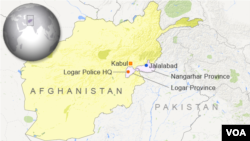The United States and NATO allies have conducted nearly 100 counterterrorism strikes in Afghanistan this year that mostly targeted Islamic State fighters and significantly reduced their numbers in the country, a spokesman said Tuesday.
U.S. Army General Charles Cleveland said in Kabul the counterterrorism strikes primarily focused on the eastern Nangarhar region bordering Pakistan.
Quoting earlier U.S. military estimates, Cleveland said there were up to 3,000 IS fighters operating in six or eight districts of the mountainous province since early 2015, when the Middle Eastern terror group emerged on the Afghan scene.
Reduced activities
During the past few weeks those numbers have been reduced to around 1,000, he said, adding IS activities have also been confined to at least one district.
Some of the “kinetic strikes” were carried out against al-Qaida militants, Cleveland noted.
The U.S. counterterrorism mission in Afghanistan began to focus on IS in January, after it was authorized to aggressively and actively target the group, he said.
“From the first of January of this year until the 31st of March, U.S. forces have taken just under 100 kinetic counterterrorism strikes. The majority of those have really been in the Nangarhar area and the majority have been focused on Daesh,” Cleveland noted, using the Arabic acronym for Islamic State militants.
General Cleveland said the U.S. military believes IS is “primarily composed of disaffected” fighters of the Pakistani Taliban extremist group and some militants of the Afghan Taliban “frustrated” with its new leadership.
He also confirmed that Afghan security forces lost about 5,500 personnel in the fight against Taliban insurgents in 2015.
Increase in casualties
The figure shows a 30 percent increase in the number of casualties Afghan forces suffered in 2014 when they had the backing of NATO forces.
But Cleveland dismissed widespread impressions the Taliban has managed to control one-third of the Afghan territory
“That is just not true. You can make the argument that one-third of the country is contested. ... But at the end of the day, we know that one-third of the nation is not under the control of the Taliban,” he asserted.
Cleveland warned the coalition fully expects the Taliban “are going to become a lot more decisively engaged” in this year’s fighting, but Afghan forces were capable of dealing with the threat.
NATO’s Resolute Support Mission in Afghanistan of around 13,000 troops, mostly Americans, are authorized to conduct counterterrorism operations and train Afghan forces.











